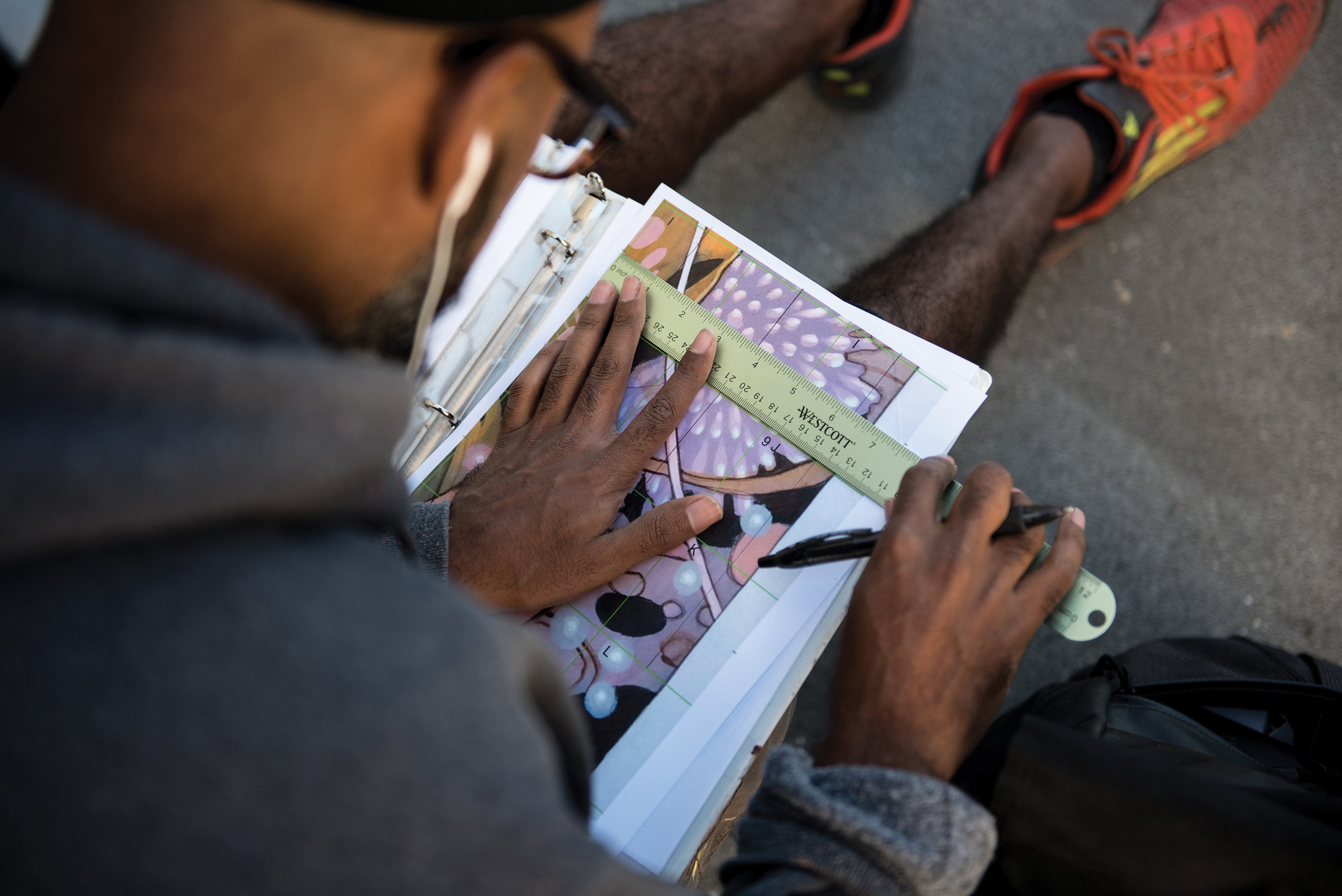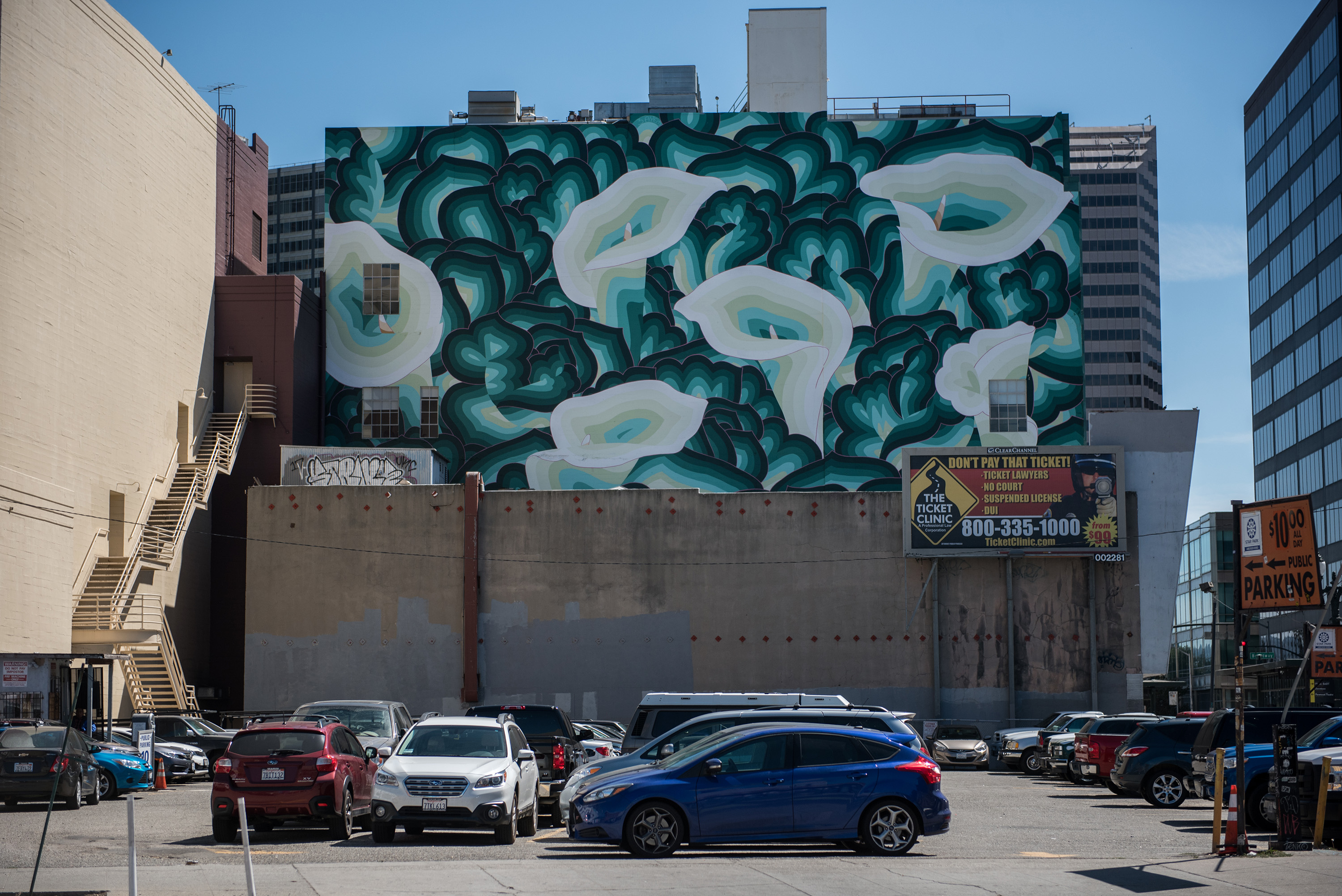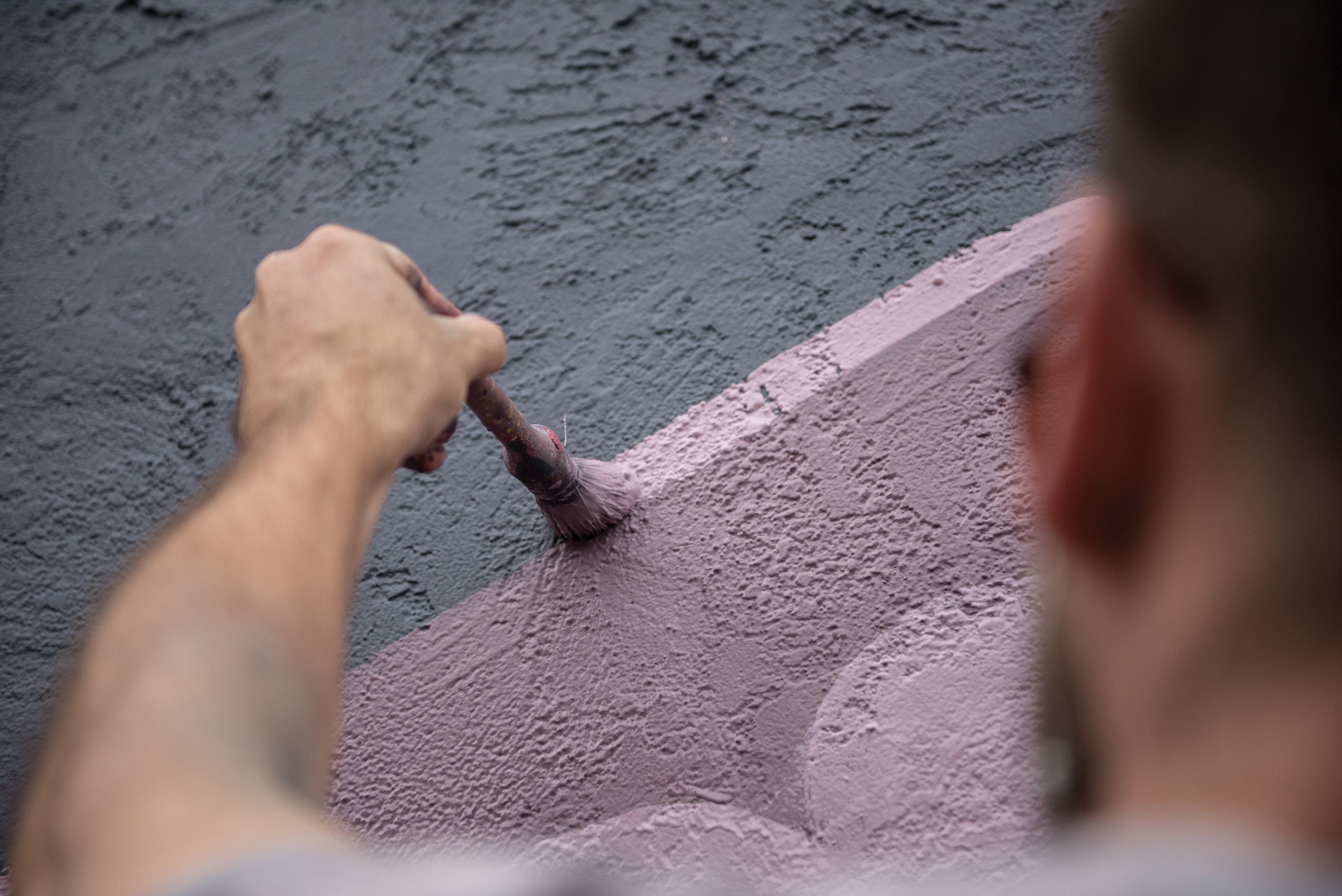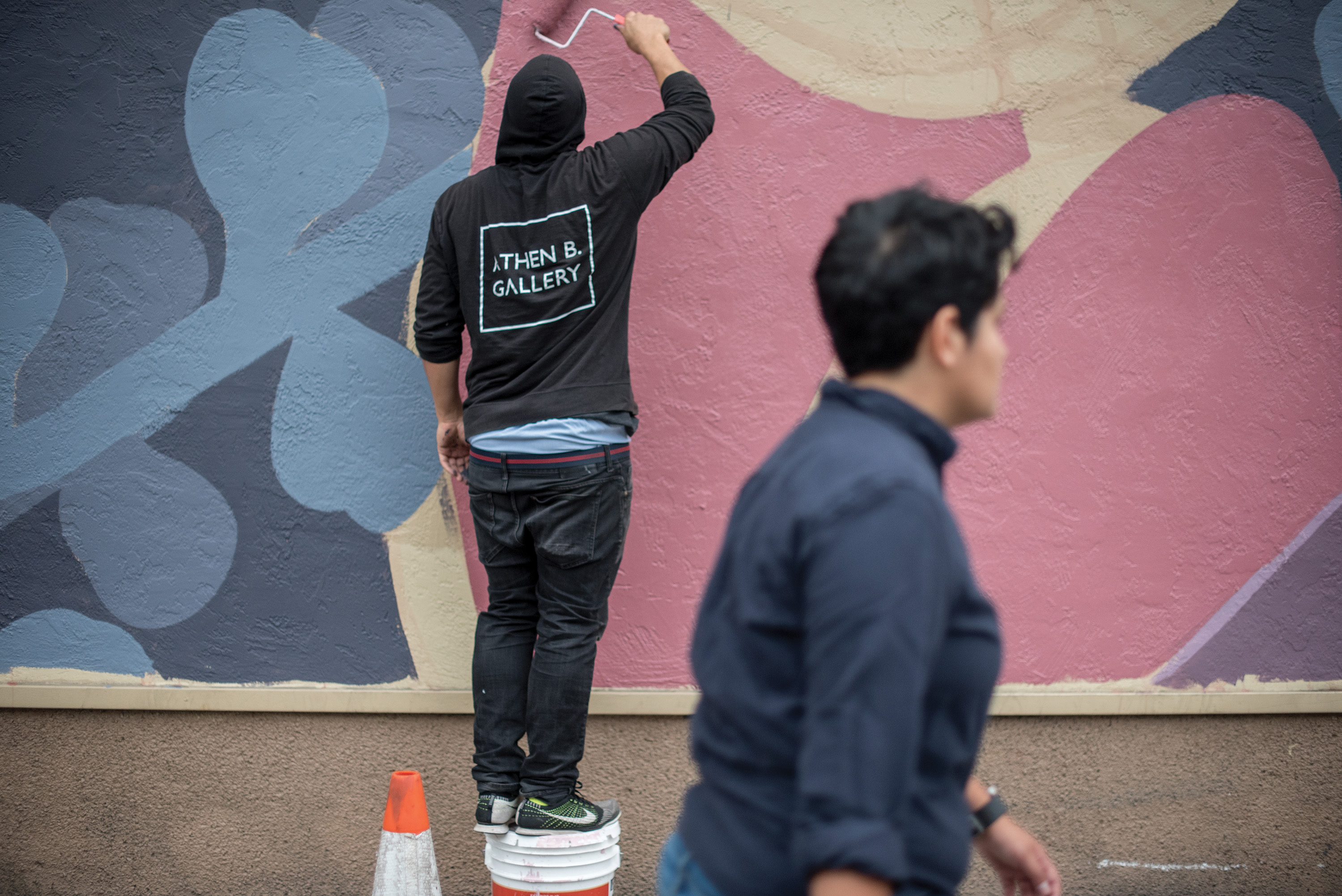To reach his concrete canvas at 1700 Broadway, Joshua Mays climbs two flights of stairs, then clambers across a tangle of rusted pipes and heating ducts and over a canted gable. From there, he straps himself into a harness and scrambles onto the kind of swing stage used by window washers, trying not to look down as the hydraulics lift him above the jigsaw of restaurants, bars, and half-constructed apartments that make up northern Oakland. The swing stage sways unsteadily as Mays brushes swirls and arcs of paint onto the empty 10-story wall that towers above Broadway. From the ground below, those strokes resolve into the face of a brown-skinned girl wearing a spangled shawl and a serene expression.
Mays, whose work is ardently Afrofuturist, says the girl is a gatekeeper to a fantastical realm, and she plays sentry in more ways than one. She is the first thing that Oakland‘s increasing influx of visitors see as they exit a nearby subway station. She’s also the vanguard of a larger trend from neglect to development in an area that, until recently, had a reputation for crime and disrepair.
Though murals have long played an important role in Oakland, a profusion of new pieces has populated the city’s Uptown neighborhood in the last several years, in concert with the tech boom that brought a wave of hipster bars, start-ups, and skyrocketing rents to the area. To the north of 1700 Broadway, an office building blossoms with trippy seafoam-green flowers; on the other side, an apartment complex is adorned with a towering figure in patchwork clothing holding a dove. Each mural has its own distinct flavor, but they have one thing in common: the stage manager behind all this art, curator and businessman Sorell Raino-Tsui.

(Photo: McNair Evans)
In the spring of 2017, the developer who owns 1700 Broadway approached Raino-Tsui about adding a mural to his property. Raino-Tsui found an artist, arranged for accident and damage insurance, helped negotiate the price ($25,000), and hired workers to scrape a crumbling top layer off the wall. In short, he did everything necessary to make the mural happen except paint it himself.
Murals are often associated with the hidden and sometimes illicit realm of street art and graffiti, and beginning muralists often start out cold-calling business owners and filling empty walls for free. But in Raino-Tsui’s world, projects like 1700 Broadway are multistage undertakings that can cost tens of thousands of dollars. He’s created a unique niche between art and business in a city experiencing growing pains: mural broker. In this role, Raino-Tsui’s task is to help define what a piece should cost in an industry where even masters sometimes work without pay; to ensure his artists get compensated accordingly; and to promote a medium that simultaneously illuminates, enlivens, and threatens the communities that surround it. He’s also acutely aware that the money suddenly available for art in his city might be paying him and his artists today, but it could be forcing them out tomorrow.

The responsibilities of a mural broker are diverse and manifold. Besides putting together artist packages and arranging equipment, he writes contracts, fills in colors on larger murals, and solves problems on the fly. He has to know who is coming up in the world of graffiti (or, as its practitioners sometimes call it, aerosol writing), maintain a mental map of taggers’ territory, and understand which artists command enough respect to keep those taggers away. He also acts as a conduit between the idealism of an artist’s vision and the pragmatism of what the project actually entails. “The artists feel more comfortable talking to me because they know me and they respect my opinion; we have a relationship,” he says. “It’s the same thing for the client.”
His early life prepared him well for this distinctive pursuit. The son of an Italian modern dancer mother and a Chinese artist-architect father, Raino-Tsui was born in British Columbia but spent much of his childhood in Oakland, joining his parents for afternoons at the dance studio or the drafting table. Those experiences, combined with a young adulthood hustling in the business world supporting a new baby, helped him build the reputation and relationships necessary to break into a fickle industry.
Among Raino-Tsui’s more unconventional tasks is establishing fair prices in a medium that often goes both overlooked and undervalued. “They get rained on, and sunned on; they deteriorate,” he says of murals, “and so there’s a lot more flexibility in pricing than there is actual canvases because that’s an item that can be taken and moved and stolen and sold.”
It’s not always easy to find a fair price that clients are willing to pay, but the rise of big-name muralists in mainstream art is changing that. The increasing popularity of artists like Shepard Fairey in established museums “does set the tone that this is ‘real’ art, and it has real value,” Raino-Tsui says. It’s a fight he seems to be winning: On a few recent occasions, he’s contracted with owners and developers who had the option to work with someone for free but chose to pay him and his artists instead.

He’s clear, though, that this isn’t only about money. For Raino-Tsui, the real value of murals lies in the way they embody culture and identity in an arena that’s free for anyone to access. And he sees power in the way art can activate an underused space: He points to a plaza not far from the Mays project that he helped transform with mural and sculpture from a “dead” and dirty space that sat empty to one where passersby eat lunch or sit in the sun. His collaborator on the project, Andrew Jones of the Downtown Oakland Association agrees. Thanks to Raino-Tsui, he says, “a 3,000-square-foot space became something more than a vacant hole.”

The city itself has helped to set the tone that this work is valuable. “Bringing art … to the public realm ultimately does something for the human body,” Jones says. The Oakland Art Murmur first established the Uptown neighborhood as an art center more than a decade ago with its monthly gallery walks, during which large swaths of the neighborhood are closed off to traffic. And Jones’ organization partners frequently with Raino-Tsui on murals and sponsors nearby Third Thursday events, where local artists exhibit and perform. Oakland also instituted a controversial new policy in 2014 requiring all new commercial development projects to contribute 1 percent of their budgets to a public art fund, or to sponsoring art around their sites.
But there’s something else going on here too, the flipside of the value that murals add to their communities. A January article in Architectural Digest calls art “the new must-have amenity for leading real estate developers,” quoting developers from Miami to Brooklyn who say they use it to attract what the story calls a “certain clientele.” Along with touting art’s power to support local artists and promote more dynamic use of public space, Oakland’s new policy explicitly cites research showing that travelers interested in the arts spend more and stay longer than others, including one report arguing that the value of urban art and culture “in its truest sense” is attracting out-of-town visitors who spend money.


Murals sit on a strange fault line in the urban landscape. In Oakland, they have long played an important role in community activism and identity. In the Fruitvale area, artists like the late Raymundo “Zala” Nevel and his daughter Xochitl Nevel Guerrero have drawn on a rich Chicano and Latino tradition of murals with ancient and sometimes spiritual roots to explore ideas around community and history. Groups like Trust Your Struggle, the Community Rejuvenation Project, and the Attitudinal Healing Connection work to create art that illuminates residents’ troubles and victories. But this art form, so essential in historically marginalized communities for expressing collective feeling or telling untold stories, can become a tool in the hands of real-estate developers to bring cachet to a neighborhood, sometimes driving out the original inhabitants.
Bay Area muralist and activist Carla Wojczuk, an artist who advocates for housing rights with the Anti-Eviction Mapping Project, has seen this dynamic before. “People want to feel the vibrancy of the culture,” she says of neighborhoods like San Francisco’s Mission District. “And combined with the latest gold rush that has been happening there, tech boom 2.0, that allows for this whole other thing where, inadvertently, the murals make it a cool place to live.”
As San Francisco’s priced-out renters head across the Bay, Oakland too has seen major economic changes that imperil its arts community. Between 2014 and 2016, rent increased an average of $549 for a one-bedroom apartment and $931 for a two-bedroom. People of color and artists of all races are particularly vulnerable to these changes: A 2015 survey by a mayoral task force looking at ways to support the city’s art found that the majority of Oakland artists see workspace and housing costs as the biggest obstacles to remaining there.

This push-and-pull relationship between artists and outsiders is the key to a deeper question about the global role of art in changing communities. A few miles from Uptown, East Oakland’s International Boulevard is bracing for the arrival of a rapid transit bus, and a series of murals on the bus shelters to go with it. East Oakland resident Daniel Buford worried in a story for local radio station KALW that the murals will “become cultural artifacts of a displaced population.” The Wynwood area of Miami famously underwent a dramatic transformation in the late 2000s, as developers used its mural scene to raise property values, eventually pricing artists out. In 2014, a group of artists painted over their own murals in Berlin because they felt their art was being similarly misused. And back in California, a mural from a Sacramento public art festival was vandalized last summer with the graffiti, “Gentrify 101: Make It Hip! (Fuck That).”

As these economic and cultural forces have buffeted Oakland, the conversation about who should be able to create and fund art in the city has become increasingly fraught. Artists arriving from elsewhere sometimes face hostility; last summer, the Argentine artist Pastel was painting a Raino-Tsui-brokered mural in Uptown when Pastel was approached by a man who angrily asked how he felt about “working for gentrification.”
Raino-Tsui argues that a community hoping to thrive creatively “can’t be this closed circuit” of purely local artists doing purely non-profit work. And Mays, who moved here eight years ago, agrees that the circulation of new ideas and perspectives are essential to public art, calling the insider/outsider conflict “oversimplified.” He says his experience as a recently arrived black artist largely embraced by the community has taught him that “local” is a complex concept. Is it about race? Is it about family history?
Isaac Abid, the developer who commissioned Mays’ mural at 1700 Broadway, was born 10 miles southeast of Oakland and prides himself on his “very local” approach to investing, including hosting arts events at his properties—but he bought the building with investors group LNG Management and concedes that he has a fiscal responsibility to those investors over existing tenants. “Who does this city belong to—to one particular cohort of people, or does it belong to everybody?” he asks, a particularly fraught question in a city fighting to remain a center of and haven for black culture and the arts in general.

For Desi Mundo, who has painted some 300 murals through his Community Rejuvenation Project, what’s important is the way artists in the city go about “engaging Oakland culture, engaging existing communities.” The problem with developer- or owner-funded work like Raino-Tsui’s, he says, is that the community that lives around the art gets no say in what their world looks like; the space can feel almost privatized, an especially problematic dynamic in the context of gentrification. “When you’re painting stuff that doesn’t reflect the community in a transitioning city, itss almost like erasing the culture,” he says. Although he understands the need for creative experimentation and growth, Mundo feels artists working in Oakland should use their work to help preserve cultural context, reminding new arrivals that they are not moving into a blank slate.
Amana Harris, the executive director of Attitudinal Healing Connection, echoes this point. For Harris, an artist’s race or origins are secondary to a genuine commitment to Oakland’s well-being and a meaningful connection with its community, what she calls “deep roots.” Harris, who grew up in West Oakland, seeks to build a sense of neighborhood ownership for Oakland kids through her work. (As she puts it, “to make sure young people in this community actually have a stake in the art that goes up—that they don’t look up and the art is just there.”) Her program is designed to teach kids to be problem-solvers of local ills like violence or pollution by creating original superheroes that are then painted in neighborhood murals. For Harris, this goal supersedes all others. “At the end of the day, I’m looking for allies,” she says. “I don’t care what they look like.”
Raino-Tsui, who sees his mixed-race background as contributing to his perspective here, splits the difference, with a stable of artists of all races that is half local and also significantly international. And while many Oaklanders mistrust building developers, he argues that working with them is one of the best ways to nurture the city’s artists. “If [developers] can get a kickass local artist to do a beautiful piece that brings hype and identity and eyes to the building, that makes that next new tech company that’s moving into Oakland want to be there more,” he says. “I get that they’re trying to play to the community, and they’re trying to sell their units. Well, I’m playing to my community, and I’m trying to put money into the hands of the people in my community.”
He looks at his work as producing a sort of Robin Hood effect, his own personal fight against artist displacement: “I don’t have the legal backing to try to fight these developers in court, that’s not my forte,” he says. “What I can do is what I know how to do: get jobs for local artists.” He thinks carefully about the way art and development interact, but says he doesn’t blame that dynamic for Oakland’s current woes.

Wojczuk feels differently. She stresses that she doesn’t know Raino-Tsui personally and that she understands the inherent complexities of making art in Oakland—but says she objects to anyone working with developers who are “not looking at stemming displacement in the city; not looking at the health and security of longtime residents, working-class residents, residents of color.” She adds that funding art “for the purpose of making those developments more enticing for higher-income people and the young tech class to move in—that’s problematic.”

How might it look if murals became not just an item of cultural and literal value but a pre-planned civic priority? For the past few years, Raino-Tsui has been working on a series of murals commissioned by the city of San Leandro, a neighboring industrial community one-fifth of Oakland’s size. San Leandro has begun to absorb some of the population that’s been priced out of Oakland and is experiencing the beginnings of a gentrification wave all its own, with 1,500 new housing units projected for construction in the next five years. In the midst of that growth, it has done something unusual: build murals into its budget.
In a recent poll asking residents how they wanted their tax revenue spent, San Leandrans voted overwhelmingly to prioritize arts and culture, ranking it in importance right after essentials like firefighters, police, and education. City administrators subsequently reached out to Raino-Tsui looking for projects celebrating the community’s roots in food production and metal fabrication.
Raino-Tsui sees the San Leandro project as an example of what the relationship between cities and their art might look like: well-thought-out, purposeful, and focused on community priorities. With the values of its residents in mind, the city has floated the possibility of its own 1 percent arts-funding requirement and long-term public-art plan. Once installed, its art pieces have become community touchstones, embraced in their respective neighborhoods.

The largest of Raino-Tsui’s murals, in the center of the city’s industrial zone, features images of workers from the factories that surround it. Stretching a full block, the work is a mix of realist portraiture and more whimsical flourishes by the artists Cannon Dill and Troy Lovegates. During the painting process, the subjects often came by with their friends to watch themselves slowly appearing on the concrete.
In the finished piece, a worker in jeans leads a flock of birds fluttering on tethers; another man wearing overalls and goggles holds an oversized wrench. Further down, a woman in an apron clutches a giant screw. Spray-paint doodles fill the space in between with playful sketches of dwellings and decor: birdhouses, small and big houses, houses giving birth to other houses. In one spot, about halfway down the block, a line of homes tied together trails onto the painted ground—homes held on a string by the workers of San Leandro, as if some day soon they might float away.
A version of this story originally appeared in the September/October 2018 issue of Pacific Standard. Subscribe now to support independent journalism in the public interest.





